Financial Accounting Report: Tesco Financial Analysis and Audit
VerifiedAdded on 2020/01/07
|18
|6063
|131
Report
AI Summary
This report provides a comprehensive analysis of financial accounting principles and practices, focusing on the application of these concepts within a business context. The report begins with an overview of accounting records, including invoices, journals, ledgers, and financial statements like the income statement and balance sheet, emphasizing their purpose and use. It then delves into fundamental accounting concepts such as the business entity, going concern, accrual accounting, prudence, and materiality, assessing their importance and meaning. Furthermore, the report evaluates the factors influencing the nature and structure of accounting systems, including legal frameworks, business complexities, levels of training, service provider differentiation, and enterprise size. The analysis extends to identifying and analyzing different components of business risk, including fraud, financial risk, marketing conditions, buyer preferences, and global marketing considerations. It examines the control systems in place, the risk of fraud, and methods for detection. Finally, the report covers planning an audit, using appropriate audit tests, recording the audit process, and preparing a draft audit report with suitable management letters.
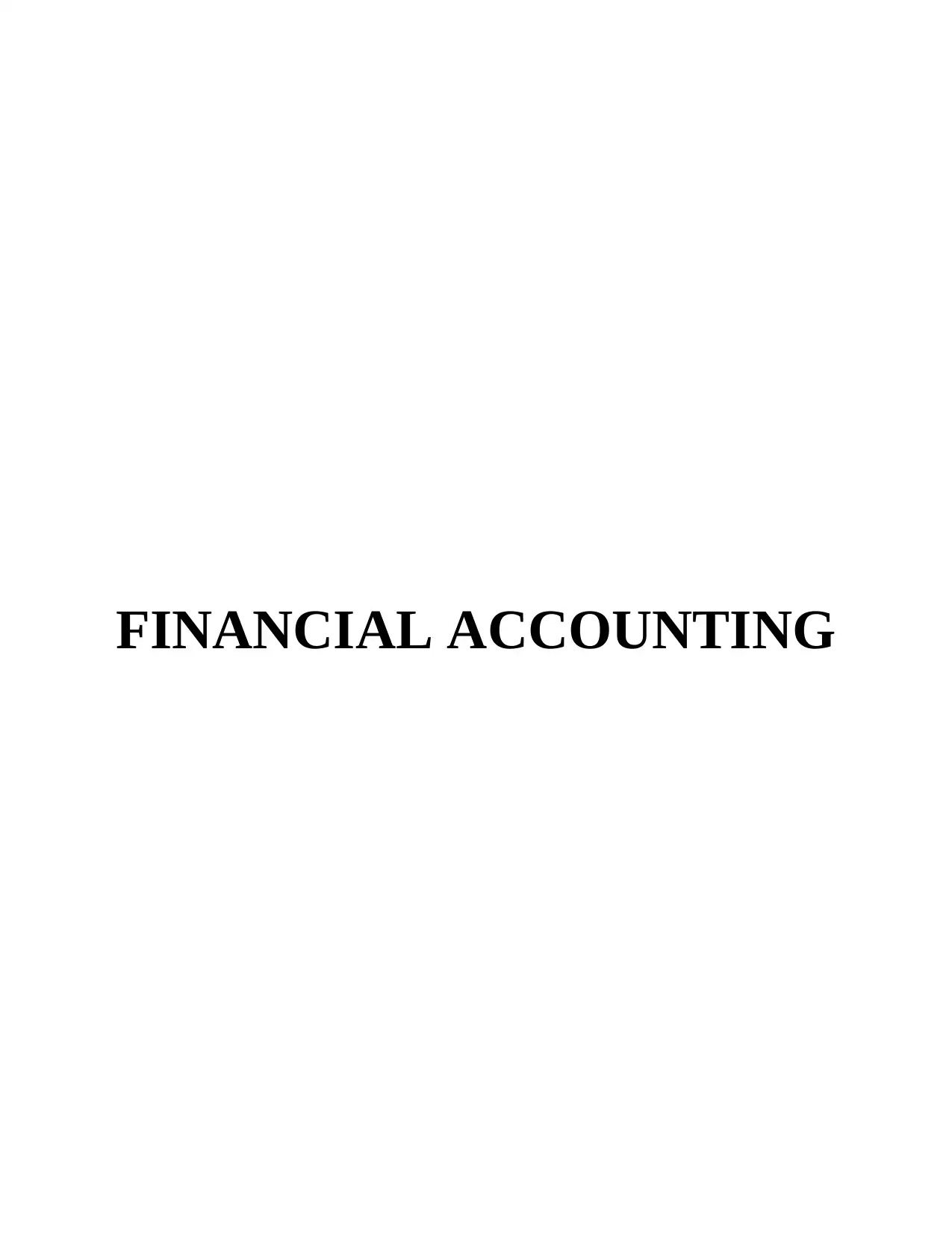
FINANCIAL ACCOUNTING
Paraphrase This Document
Need a fresh take? Get an instant paraphrase of this document with our AI Paraphraser
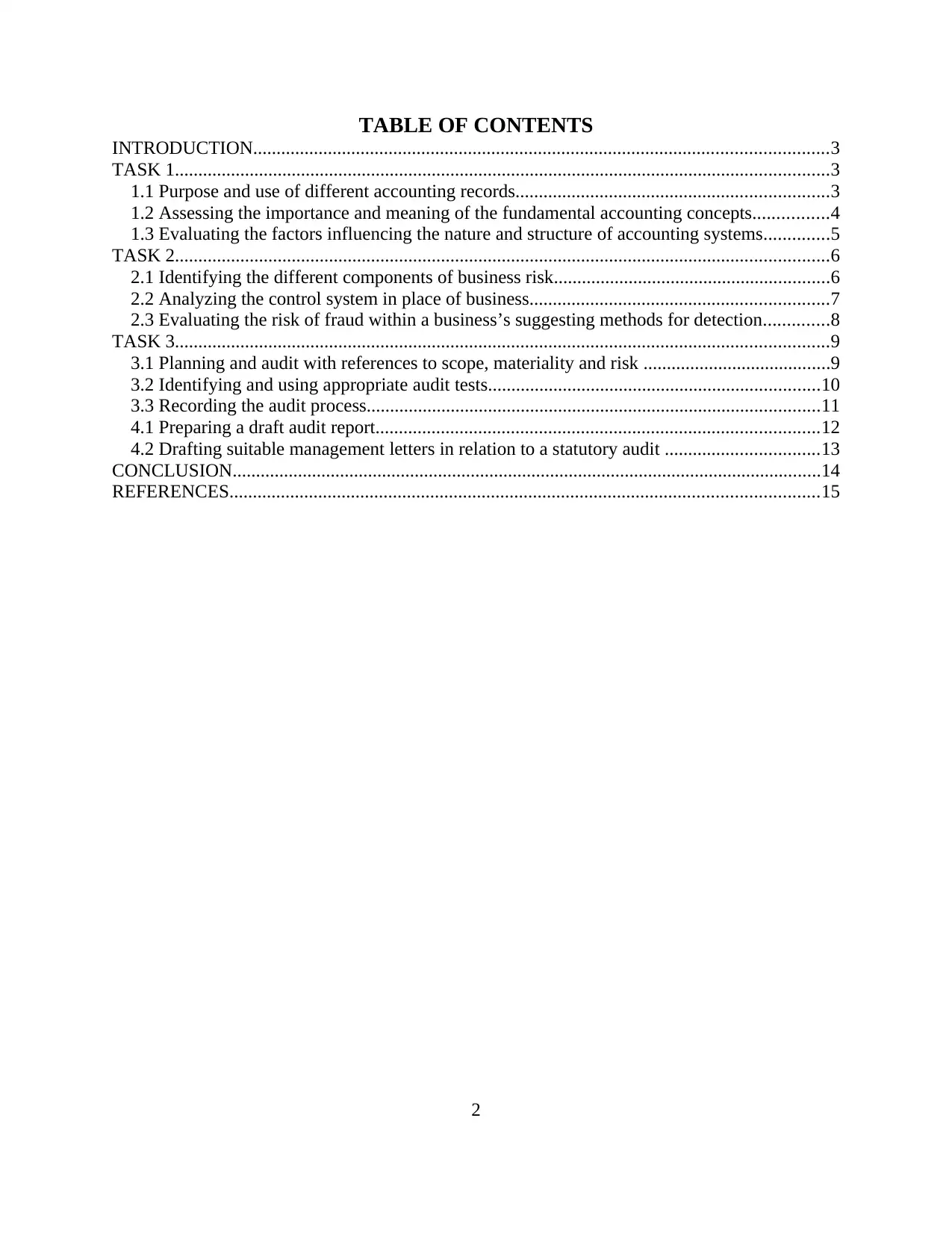
TABLE OF CONTENTS
INTRODUCTION...........................................................................................................................3
TASK 1............................................................................................................................................3
1.1 Purpose and use of different accounting records...................................................................3
1.2 Assessing the importance and meaning of the fundamental accounting concepts................4
1.3 Evaluating the factors influencing the nature and structure of accounting systems..............5
TASK 2............................................................................................................................................6
2.1 Identifying the different components of business risk...........................................................6
2.2 Analyzing the control system in place of business................................................................7
2.3 Evaluating the risk of fraud within a business’s suggesting methods for detection..............8
TASK 3............................................................................................................................................9
3.1 Planning and audit with references to scope, materiality and risk ........................................9
3.2 Identifying and using appropriate audit tests.......................................................................10
3.3 Recording the audit process.................................................................................................11
4.1 Preparing a draft audit report...............................................................................................12
4.2 Drafting suitable management letters in relation to a statutory audit .................................13
CONCLUSION..............................................................................................................................14
REFERENCES..............................................................................................................................15
2
INTRODUCTION...........................................................................................................................3
TASK 1............................................................................................................................................3
1.1 Purpose and use of different accounting records...................................................................3
1.2 Assessing the importance and meaning of the fundamental accounting concepts................4
1.3 Evaluating the factors influencing the nature and structure of accounting systems..............5
TASK 2............................................................................................................................................6
2.1 Identifying the different components of business risk...........................................................6
2.2 Analyzing the control system in place of business................................................................7
2.3 Evaluating the risk of fraud within a business’s suggesting methods for detection..............8
TASK 3............................................................................................................................................9
3.1 Planning and audit with references to scope, materiality and risk ........................................9
3.2 Identifying and using appropriate audit tests.......................................................................10
3.3 Recording the audit process.................................................................................................11
4.1 Preparing a draft audit report...............................................................................................12
4.2 Drafting suitable management letters in relation to a statutory audit .................................13
CONCLUSION..............................................................................................................................14
REFERENCES..............................................................................................................................15
2
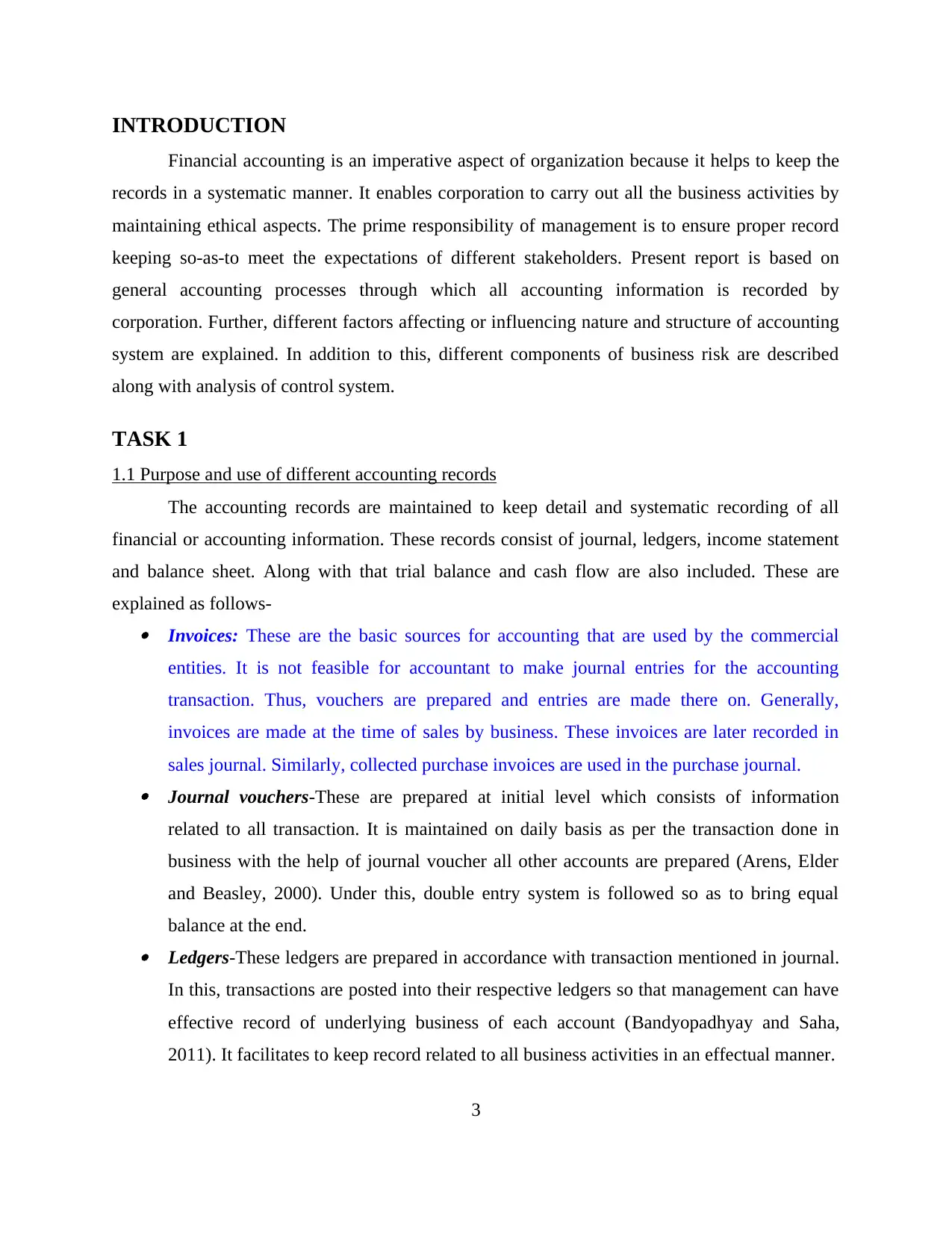
INTRODUCTION
Financial accounting is an imperative aspect of organization because it helps to keep the
records in a systematic manner. It enables corporation to carry out all the business activities by
maintaining ethical aspects. The prime responsibility of management is to ensure proper record
keeping so-as-to meet the expectations of different stakeholders. Present report is based on
general accounting processes through which all accounting information is recorded by
corporation. Further, different factors affecting or influencing nature and structure of accounting
system are explained. In addition to this, different components of business risk are described
along with analysis of control system.
TASK 1
1.1 Purpose and use of different accounting records
The accounting records are maintained to keep detail and systematic recording of all
financial or accounting information. These records consist of journal, ledgers, income statement
and balance sheet. Along with that trial balance and cash flow are also included. These are
explained as follows- Invoices: These are the basic sources for accounting that are used by the commercial
entities. It is not feasible for accountant to make journal entries for the accounting
transaction. Thus, vouchers are prepared and entries are made there on. Generally,
invoices are made at the time of sales by business. These invoices are later recorded in
sales journal. Similarly, collected purchase invoices are used in the purchase journal. Journal vouchers-These are prepared at initial level which consists of information
related to all transaction. It is maintained on daily basis as per the transaction done in
business with the help of journal voucher all other accounts are prepared (Arens, Elder
and Beasley, 2000). Under this, double entry system is followed so as to bring equal
balance at the end. Ledgers-These ledgers are prepared in accordance with transaction mentioned in journal.
In this, transactions are posted into their respective ledgers so that management can have
effective record of underlying business of each account (Bandyopadhyay and Saha,
2011). It facilitates to keep record related to all business activities in an effectual manner.
3
Financial accounting is an imperative aspect of organization because it helps to keep the
records in a systematic manner. It enables corporation to carry out all the business activities by
maintaining ethical aspects. The prime responsibility of management is to ensure proper record
keeping so-as-to meet the expectations of different stakeholders. Present report is based on
general accounting processes through which all accounting information is recorded by
corporation. Further, different factors affecting or influencing nature and structure of accounting
system are explained. In addition to this, different components of business risk are described
along with analysis of control system.
TASK 1
1.1 Purpose and use of different accounting records
The accounting records are maintained to keep detail and systematic recording of all
financial or accounting information. These records consist of journal, ledgers, income statement
and balance sheet. Along with that trial balance and cash flow are also included. These are
explained as follows- Invoices: These are the basic sources for accounting that are used by the commercial
entities. It is not feasible for accountant to make journal entries for the accounting
transaction. Thus, vouchers are prepared and entries are made there on. Generally,
invoices are made at the time of sales by business. These invoices are later recorded in
sales journal. Similarly, collected purchase invoices are used in the purchase journal. Journal vouchers-These are prepared at initial level which consists of information
related to all transaction. It is maintained on daily basis as per the transaction done in
business with the help of journal voucher all other accounts are prepared (Arens, Elder
and Beasley, 2000). Under this, double entry system is followed so as to bring equal
balance at the end. Ledgers-These ledgers are prepared in accordance with transaction mentioned in journal.
In this, transactions are posted into their respective ledgers so that management can have
effective record of underlying business of each account (Bandyopadhyay and Saha,
2011). It facilitates to keep record related to all business activities in an effectual manner.
3
⊘ This is a preview!⊘
Do you want full access?
Subscribe today to unlock all pages.

Trusted by 1+ million students worldwide
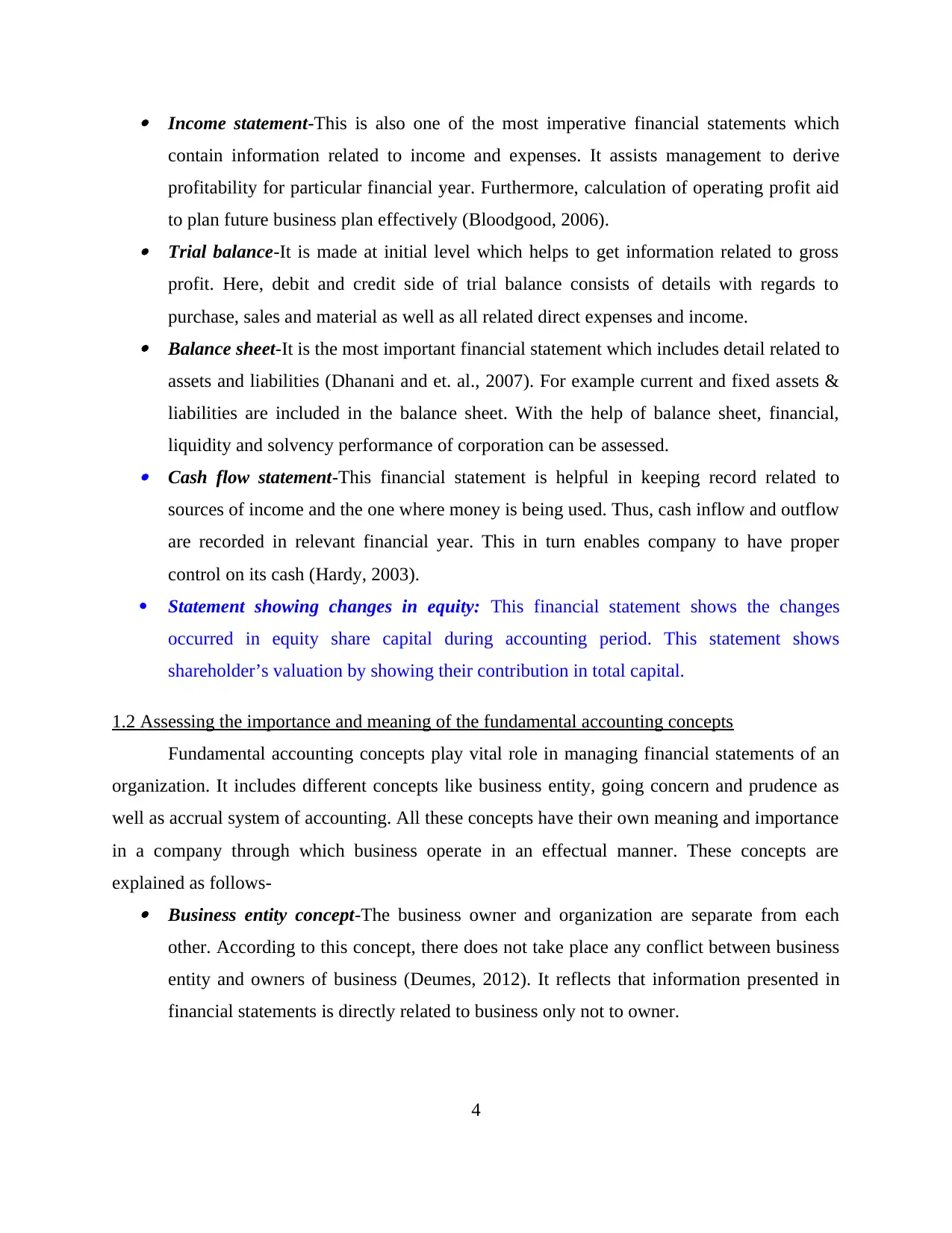
Income statement-This is also one of the most imperative financial statements which
contain information related to income and expenses. It assists management to derive
profitability for particular financial year. Furthermore, calculation of operating profit aid
to plan future business plan effectively (Bloodgood, 2006). Trial balance-It is made at initial level which helps to get information related to gross
profit. Here, debit and credit side of trial balance consists of details with regards to
purchase, sales and material as well as all related direct expenses and income. Balance sheet-It is the most important financial statement which includes detail related to
assets and liabilities (Dhanani and et. al., 2007). For example current and fixed assets &
liabilities are included in the balance sheet. With the help of balance sheet, financial,
liquidity and solvency performance of corporation can be assessed. Cash flow statement-This financial statement is helpful in keeping record related to
sources of income and the one where money is being used. Thus, cash inflow and outflow
are recorded in relevant financial year. This in turn enables company to have proper
control on its cash (Hardy, 2003).
Statement showing changes in equity: This financial statement shows the changes
occurred in equity share capital during accounting period. This statement shows
shareholder’s valuation by showing their contribution in total capital.
1.2 Assessing the importance and meaning of the fundamental accounting concepts
Fundamental accounting concepts play vital role in managing financial statements of an
organization. It includes different concepts like business entity, going concern and prudence as
well as accrual system of accounting. All these concepts have their own meaning and importance
in a company through which business operate in an effectual manner. These concepts are
explained as follows- Business entity concept-The business owner and organization are separate from each
other. According to this concept, there does not take place any conflict between business
entity and owners of business (Deumes, 2012). It reflects that information presented in
financial statements is directly related to business only not to owner.
4
contain information related to income and expenses. It assists management to derive
profitability for particular financial year. Furthermore, calculation of operating profit aid
to plan future business plan effectively (Bloodgood, 2006). Trial balance-It is made at initial level which helps to get information related to gross
profit. Here, debit and credit side of trial balance consists of details with regards to
purchase, sales and material as well as all related direct expenses and income. Balance sheet-It is the most important financial statement which includes detail related to
assets and liabilities (Dhanani and et. al., 2007). For example current and fixed assets &
liabilities are included in the balance sheet. With the help of balance sheet, financial,
liquidity and solvency performance of corporation can be assessed. Cash flow statement-This financial statement is helpful in keeping record related to
sources of income and the one where money is being used. Thus, cash inflow and outflow
are recorded in relevant financial year. This in turn enables company to have proper
control on its cash (Hardy, 2003).
Statement showing changes in equity: This financial statement shows the changes
occurred in equity share capital during accounting period. This statement shows
shareholder’s valuation by showing their contribution in total capital.
1.2 Assessing the importance and meaning of the fundamental accounting concepts
Fundamental accounting concepts play vital role in managing financial statements of an
organization. It includes different concepts like business entity, going concern and prudence as
well as accrual system of accounting. All these concepts have their own meaning and importance
in a company through which business operate in an effectual manner. These concepts are
explained as follows- Business entity concept-The business owner and organization are separate from each
other. According to this concept, there does not take place any conflict between business
entity and owners of business (Deumes, 2012). It reflects that information presented in
financial statements is directly related to business only not to owner.
4
Paraphrase This Document
Need a fresh take? Get an instant paraphrase of this document with our AI Paraphraser
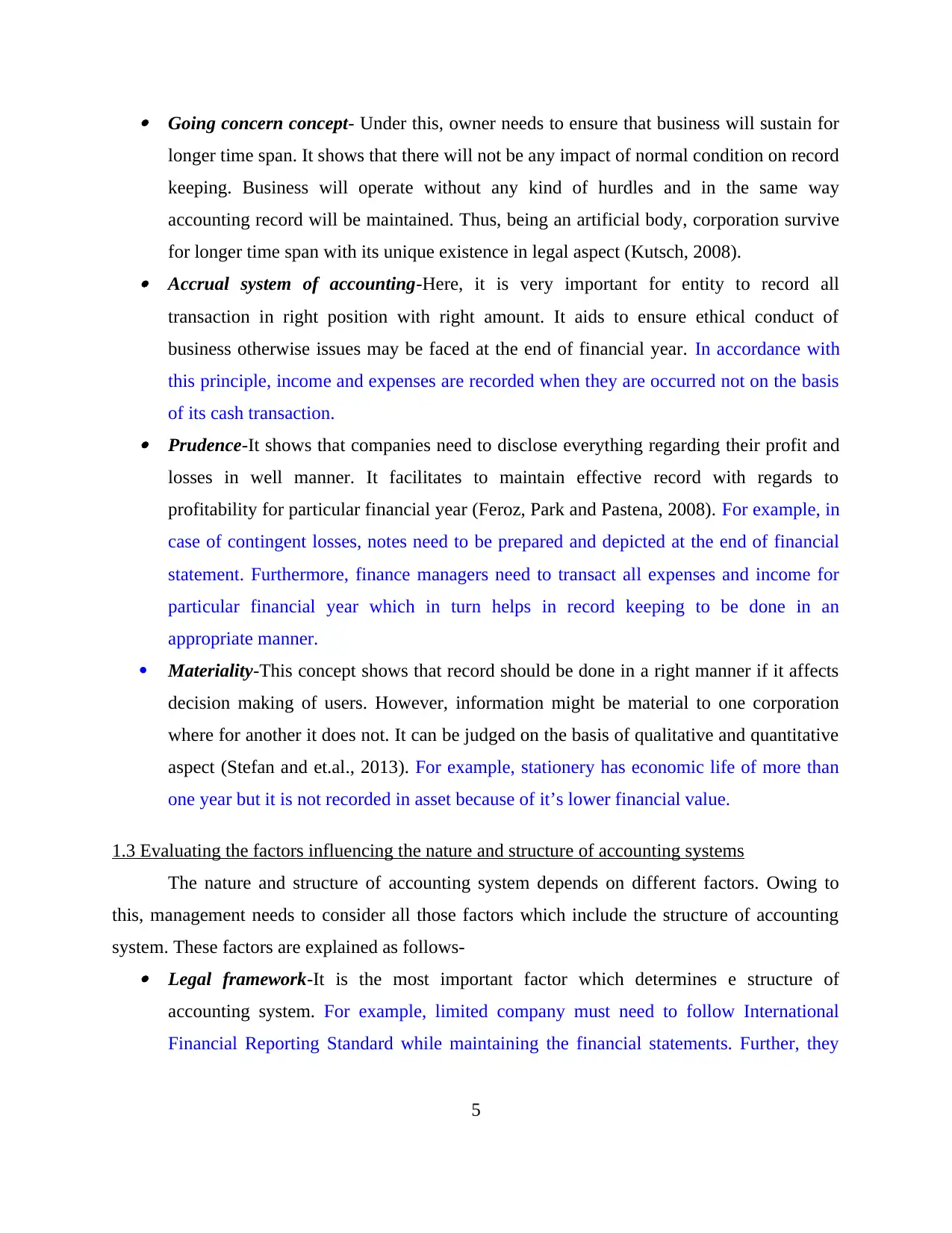
Going concern concept- Under this, owner needs to ensure that business will sustain for
longer time span. It shows that there will not be any impact of normal condition on record
keeping. Business will operate without any kind of hurdles and in the same way
accounting record will be maintained. Thus, being an artificial body, corporation survive
for longer time span with its unique existence in legal aspect (Kutsch, 2008). Accrual system of accounting-Here, it is very important for entity to record all
transaction in right position with right amount. It aids to ensure ethical conduct of
business otherwise issues may be faced at the end of financial year. In accordance with
this principle, income and expenses are recorded when they are occurred not on the basis
of its cash transaction. Prudence-It shows that companies need to disclose everything regarding their profit and
losses in well manner. It facilitates to maintain effective record with regards to
profitability for particular financial year (Feroz, Park and Pastena, 2008). For example, in
case of contingent losses, notes need to be prepared and depicted at the end of financial
statement. Furthermore, finance managers need to transact all expenses and income for
particular financial year which in turn helps in record keeping to be done in an
appropriate manner.
Materiality-This concept shows that record should be done in a right manner if it affects
decision making of users. However, information might be material to one corporation
where for another it does not. It can be judged on the basis of qualitative and quantitative
aspect (Stefan and et.al., 2013). For example, stationery has economic life of more than
one year but it is not recorded in asset because of it’s lower financial value.
1.3 Evaluating the factors influencing the nature and structure of accounting systems
The nature and structure of accounting system depends on different factors. Owing to
this, management needs to consider all those factors which include the structure of accounting
system. These factors are explained as follows- Legal framework-It is the most important factor which determines e structure of
accounting system. For example, limited company must need to follow International
Financial Reporting Standard while maintaining the financial statements. Further, they
5
longer time span. It shows that there will not be any impact of normal condition on record
keeping. Business will operate without any kind of hurdles and in the same way
accounting record will be maintained. Thus, being an artificial body, corporation survive
for longer time span with its unique existence in legal aspect (Kutsch, 2008). Accrual system of accounting-Here, it is very important for entity to record all
transaction in right position with right amount. It aids to ensure ethical conduct of
business otherwise issues may be faced at the end of financial year. In accordance with
this principle, income and expenses are recorded when they are occurred not on the basis
of its cash transaction. Prudence-It shows that companies need to disclose everything regarding their profit and
losses in well manner. It facilitates to maintain effective record with regards to
profitability for particular financial year (Feroz, Park and Pastena, 2008). For example, in
case of contingent losses, notes need to be prepared and depicted at the end of financial
statement. Furthermore, finance managers need to transact all expenses and income for
particular financial year which in turn helps in record keeping to be done in an
appropriate manner.
Materiality-This concept shows that record should be done in a right manner if it affects
decision making of users. However, information might be material to one corporation
where for another it does not. It can be judged on the basis of qualitative and quantitative
aspect (Stefan and et.al., 2013). For example, stationery has economic life of more than
one year but it is not recorded in asset because of it’s lower financial value.
1.3 Evaluating the factors influencing the nature and structure of accounting systems
The nature and structure of accounting system depends on different factors. Owing to
this, management needs to consider all those factors which include the structure of accounting
system. These factors are explained as follows- Legal framework-It is the most important factor which determines e structure of
accounting system. For example, limited company must need to follow International
Financial Reporting Standard while maintaining the financial statements. Further, they
5
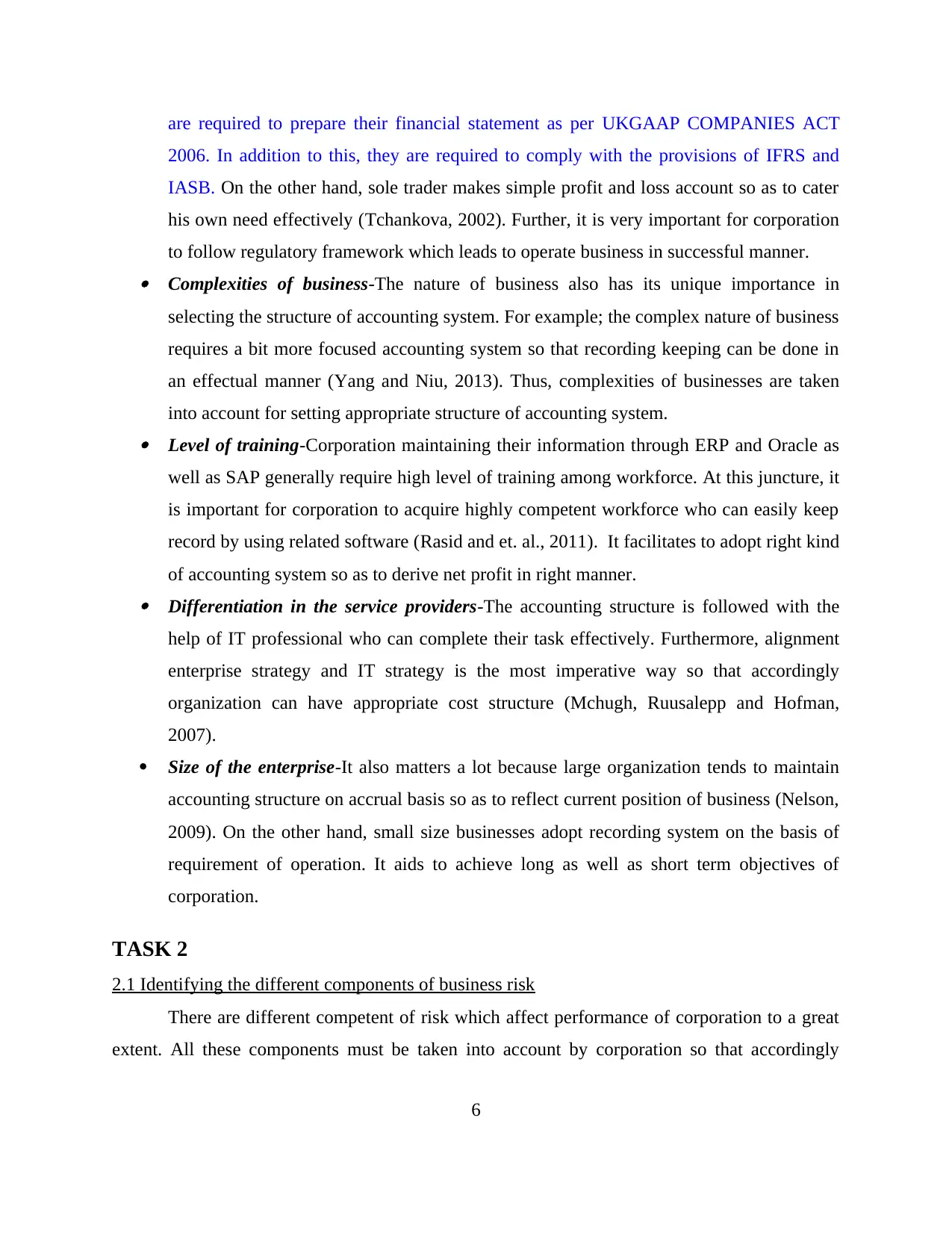
are required to prepare their financial statement as per UKGAAP COMPANIES ACT
2006. In addition to this, they are required to comply with the provisions of IFRS and
IASB. On the other hand, sole trader makes simple profit and loss account so as to cater
his own need effectively (Tchankova, 2002). Further, it is very important for corporation
to follow regulatory framework which leads to operate business in successful manner. Complexities of business-The nature of business also has its unique importance in
selecting the structure of accounting system. For example; the complex nature of business
requires a bit more focused accounting system so that recording keeping can be done in
an effectual manner (Yang and Niu, 2013). Thus, complexities of businesses are taken
into account for setting appropriate structure of accounting system. Level of training-Corporation maintaining their information through ERP and Oracle as
well as SAP generally require high level of training among workforce. At this juncture, it
is important for corporation to acquire highly competent workforce who can easily keep
record by using related software (Rasid and et. al., 2011). It facilitates to adopt right kind
of accounting system so as to derive net profit in right manner. Differentiation in the service providers-The accounting structure is followed with the
help of IT professional who can complete their task effectively. Furthermore, alignment
enterprise strategy and IT strategy is the most imperative way so that accordingly
organization can have appropriate cost structure (Mchugh, Ruusalepp and Hofman,
2007).
Size of the enterprise-It also matters a lot because large organization tends to maintain
accounting structure on accrual basis so as to reflect current position of business (Nelson,
2009). On the other hand, small size businesses adopt recording system on the basis of
requirement of operation. It aids to achieve long as well as short term objectives of
corporation.
TASK 2
2.1 Identifying the different components of business risk
There are different competent of risk which affect performance of corporation to a great
extent. All these components must be taken into account by corporation so that accordingly
6
2006. In addition to this, they are required to comply with the provisions of IFRS and
IASB. On the other hand, sole trader makes simple profit and loss account so as to cater
his own need effectively (Tchankova, 2002). Further, it is very important for corporation
to follow regulatory framework which leads to operate business in successful manner. Complexities of business-The nature of business also has its unique importance in
selecting the structure of accounting system. For example; the complex nature of business
requires a bit more focused accounting system so that recording keeping can be done in
an effectual manner (Yang and Niu, 2013). Thus, complexities of businesses are taken
into account for setting appropriate structure of accounting system. Level of training-Corporation maintaining their information through ERP and Oracle as
well as SAP generally require high level of training among workforce. At this juncture, it
is important for corporation to acquire highly competent workforce who can easily keep
record by using related software (Rasid and et. al., 2011). It facilitates to adopt right kind
of accounting system so as to derive net profit in right manner. Differentiation in the service providers-The accounting structure is followed with the
help of IT professional who can complete their task effectively. Furthermore, alignment
enterprise strategy and IT strategy is the most imperative way so that accordingly
organization can have appropriate cost structure (Mchugh, Ruusalepp and Hofman,
2007).
Size of the enterprise-It also matters a lot because large organization tends to maintain
accounting structure on accrual basis so as to reflect current position of business (Nelson,
2009). On the other hand, small size businesses adopt recording system on the basis of
requirement of operation. It aids to achieve long as well as short term objectives of
corporation.
TASK 2
2.1 Identifying the different components of business risk
There are different competent of risk which affect performance of corporation to a great
extent. All these components must be taken into account by corporation so that accordingly
6
⊘ This is a preview!⊘
Do you want full access?
Subscribe today to unlock all pages.

Trusted by 1+ million students worldwide
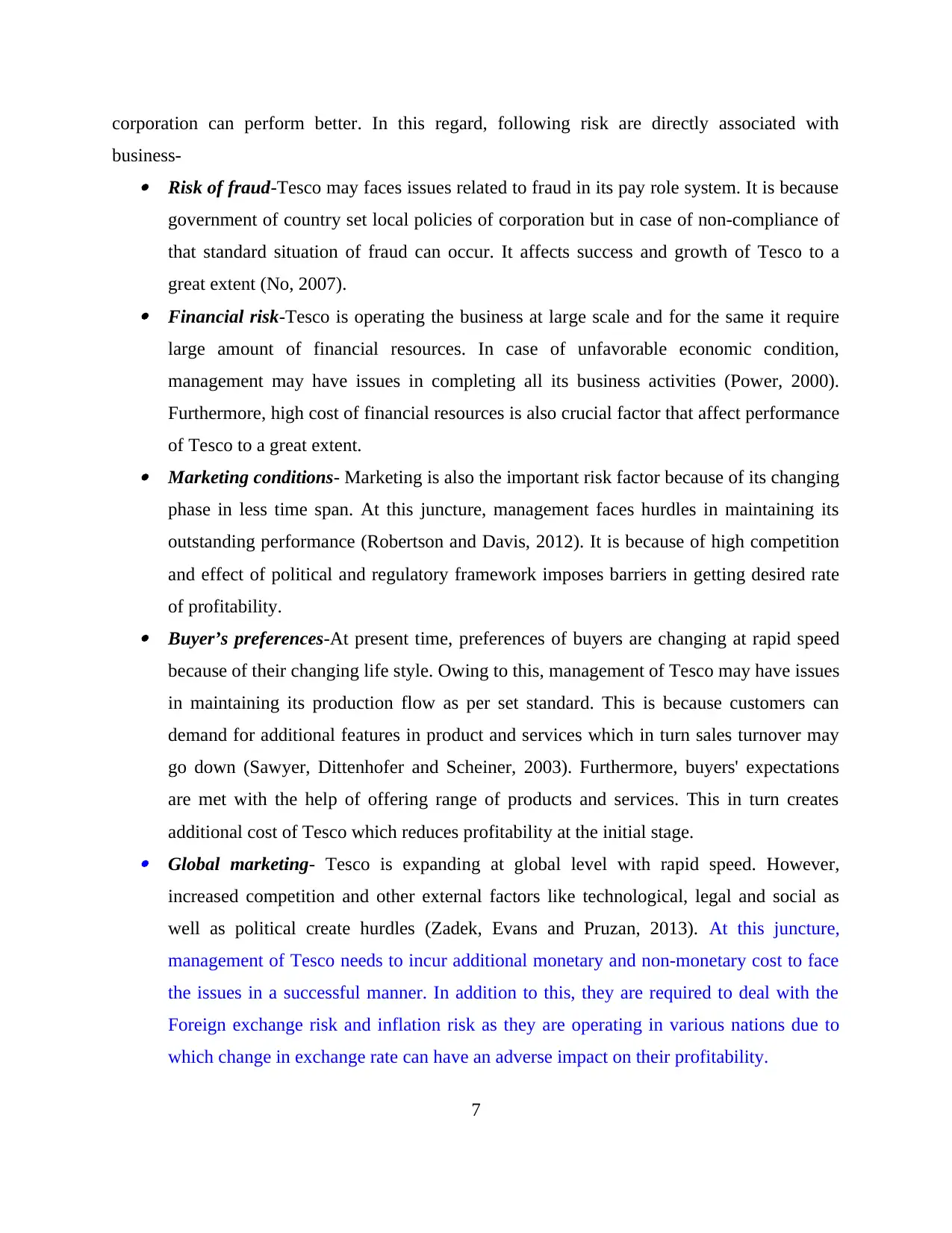
corporation can perform better. In this regard, following risk are directly associated with
business- Risk of fraud-Tesco may faces issues related to fraud in its pay role system. It is because
government of country set local policies of corporation but in case of non-compliance of
that standard situation of fraud can occur. It affects success and growth of Tesco to a
great extent (No, 2007). Financial risk-Tesco is operating the business at large scale and for the same it require
large amount of financial resources. In case of unfavorable economic condition,
management may have issues in completing all its business activities (Power, 2000).
Furthermore, high cost of financial resources is also crucial factor that affect performance
of Tesco to a great extent. Marketing conditions- Marketing is also the important risk factor because of its changing
phase in less time span. At this juncture, management faces hurdles in maintaining its
outstanding performance (Robertson and Davis, 2012). It is because of high competition
and effect of political and regulatory framework imposes barriers in getting desired rate
of profitability. Buyer’s preferences-At present time, preferences of buyers are changing at rapid speed
because of their changing life style. Owing to this, management of Tesco may have issues
in maintaining its production flow as per set standard. This is because customers can
demand for additional features in product and services which in turn sales turnover may
go down (Sawyer, Dittenhofer and Scheiner, 2003). Furthermore, buyers' expectations
are met with the help of offering range of products and services. This in turn creates
additional cost of Tesco which reduces profitability at the initial stage. Global marketing- Tesco is expanding at global level with rapid speed. However,
increased competition and other external factors like technological, legal and social as
well as political create hurdles (Zadek, Evans and Pruzan, 2013). At this juncture,
management of Tesco needs to incur additional monetary and non-monetary cost to face
the issues in a successful manner. In addition to this, they are required to deal with the
Foreign exchange risk and inflation risk as they are operating in various nations due to
which change in exchange rate can have an adverse impact on their profitability.
7
business- Risk of fraud-Tesco may faces issues related to fraud in its pay role system. It is because
government of country set local policies of corporation but in case of non-compliance of
that standard situation of fraud can occur. It affects success and growth of Tesco to a
great extent (No, 2007). Financial risk-Tesco is operating the business at large scale and for the same it require
large amount of financial resources. In case of unfavorable economic condition,
management may have issues in completing all its business activities (Power, 2000).
Furthermore, high cost of financial resources is also crucial factor that affect performance
of Tesco to a great extent. Marketing conditions- Marketing is also the important risk factor because of its changing
phase in less time span. At this juncture, management faces hurdles in maintaining its
outstanding performance (Robertson and Davis, 2012). It is because of high competition
and effect of political and regulatory framework imposes barriers in getting desired rate
of profitability. Buyer’s preferences-At present time, preferences of buyers are changing at rapid speed
because of their changing life style. Owing to this, management of Tesco may have issues
in maintaining its production flow as per set standard. This is because customers can
demand for additional features in product and services which in turn sales turnover may
go down (Sawyer, Dittenhofer and Scheiner, 2003). Furthermore, buyers' expectations
are met with the help of offering range of products and services. This in turn creates
additional cost of Tesco which reduces profitability at the initial stage. Global marketing- Tesco is expanding at global level with rapid speed. However,
increased competition and other external factors like technological, legal and social as
well as political create hurdles (Zadek, Evans and Pruzan, 2013). At this juncture,
management of Tesco needs to incur additional monetary and non-monetary cost to face
the issues in a successful manner. In addition to this, they are required to deal with the
Foreign exchange risk and inflation risk as they are operating in various nations due to
which change in exchange rate can have an adverse impact on their profitability.
7
Paraphrase This Document
Need a fresh take? Get an instant paraphrase of this document with our AI Paraphraser
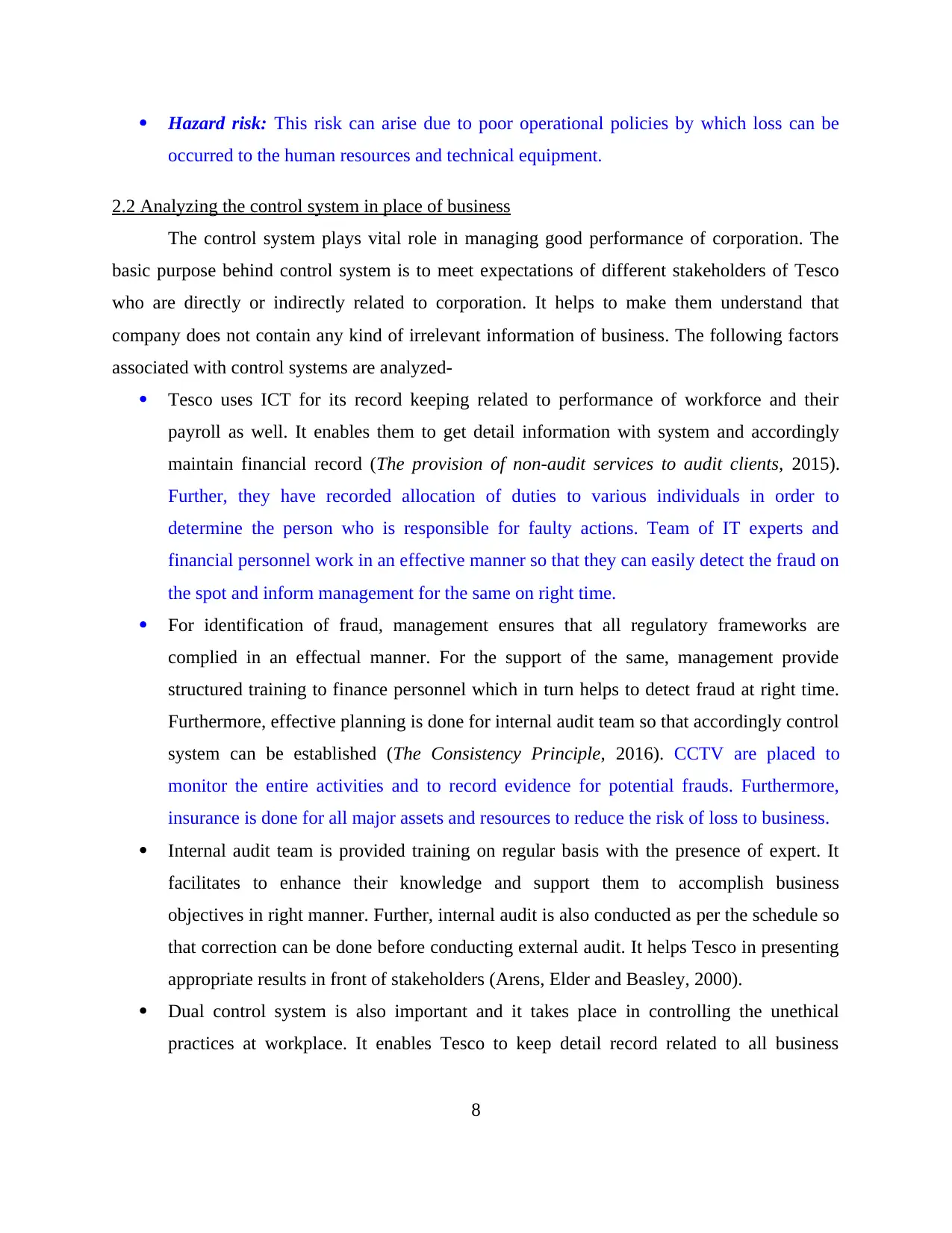
Hazard risk: This risk can arise due to poor operational policies by which loss can be
occurred to the human resources and technical equipment.
2.2 Analyzing the control system in place of business
The control system plays vital role in managing good performance of corporation. The
basic purpose behind control system is to meet expectations of different stakeholders of Tesco
who are directly or indirectly related to corporation. It helps to make them understand that
company does not contain any kind of irrelevant information of business. The following factors
associated with control systems are analyzed-
Tesco uses ICT for its record keeping related to performance of workforce and their
payroll as well. It enables them to get detail information with system and accordingly
maintain financial record (The provision of non-audit services to audit clients, 2015).
Further, they have recorded allocation of duties to various individuals in order to
determine the person who is responsible for faulty actions. Team of IT experts and
financial personnel work in an effective manner so that they can easily detect the fraud on
the spot and inform management for the same on right time.
For identification of fraud, management ensures that all regulatory frameworks are
complied in an effectual manner. For the support of the same, management provide
structured training to finance personnel which in turn helps to detect fraud at right time.
Furthermore, effective planning is done for internal audit team so that accordingly control
system can be established (The Consistency Principle, 2016). CCTV are placed to
monitor the entire activities and to record evidence for potential frauds. Furthermore,
insurance is done for all major assets and resources to reduce the risk of loss to business.
Internal audit team is provided training on regular basis with the presence of expert. It
facilitates to enhance their knowledge and support them to accomplish business
objectives in right manner. Further, internal audit is also conducted as per the schedule so
that correction can be done before conducting external audit. It helps Tesco in presenting
appropriate results in front of stakeholders (Arens, Elder and Beasley, 2000).
Dual control system is also important and it takes place in controlling the unethical
practices at workplace. It enables Tesco to keep detail record related to all business
8
occurred to the human resources and technical equipment.
2.2 Analyzing the control system in place of business
The control system plays vital role in managing good performance of corporation. The
basic purpose behind control system is to meet expectations of different stakeholders of Tesco
who are directly or indirectly related to corporation. It helps to make them understand that
company does not contain any kind of irrelevant information of business. The following factors
associated with control systems are analyzed-
Tesco uses ICT for its record keeping related to performance of workforce and their
payroll as well. It enables them to get detail information with system and accordingly
maintain financial record (The provision of non-audit services to audit clients, 2015).
Further, they have recorded allocation of duties to various individuals in order to
determine the person who is responsible for faulty actions. Team of IT experts and
financial personnel work in an effective manner so that they can easily detect the fraud on
the spot and inform management for the same on right time.
For identification of fraud, management ensures that all regulatory frameworks are
complied in an effectual manner. For the support of the same, management provide
structured training to finance personnel which in turn helps to detect fraud at right time.
Furthermore, effective planning is done for internal audit team so that accordingly control
system can be established (The Consistency Principle, 2016). CCTV are placed to
monitor the entire activities and to record evidence for potential frauds. Furthermore,
insurance is done for all major assets and resources to reduce the risk of loss to business.
Internal audit team is provided training on regular basis with the presence of expert. It
facilitates to enhance their knowledge and support them to accomplish business
objectives in right manner. Further, internal audit is also conducted as per the schedule so
that correction can be done before conducting external audit. It helps Tesco in presenting
appropriate results in front of stakeholders (Arens, Elder and Beasley, 2000).
Dual control system is also important and it takes place in controlling the unethical
practices at workplace. It enables Tesco to keep detail record related to all business
8
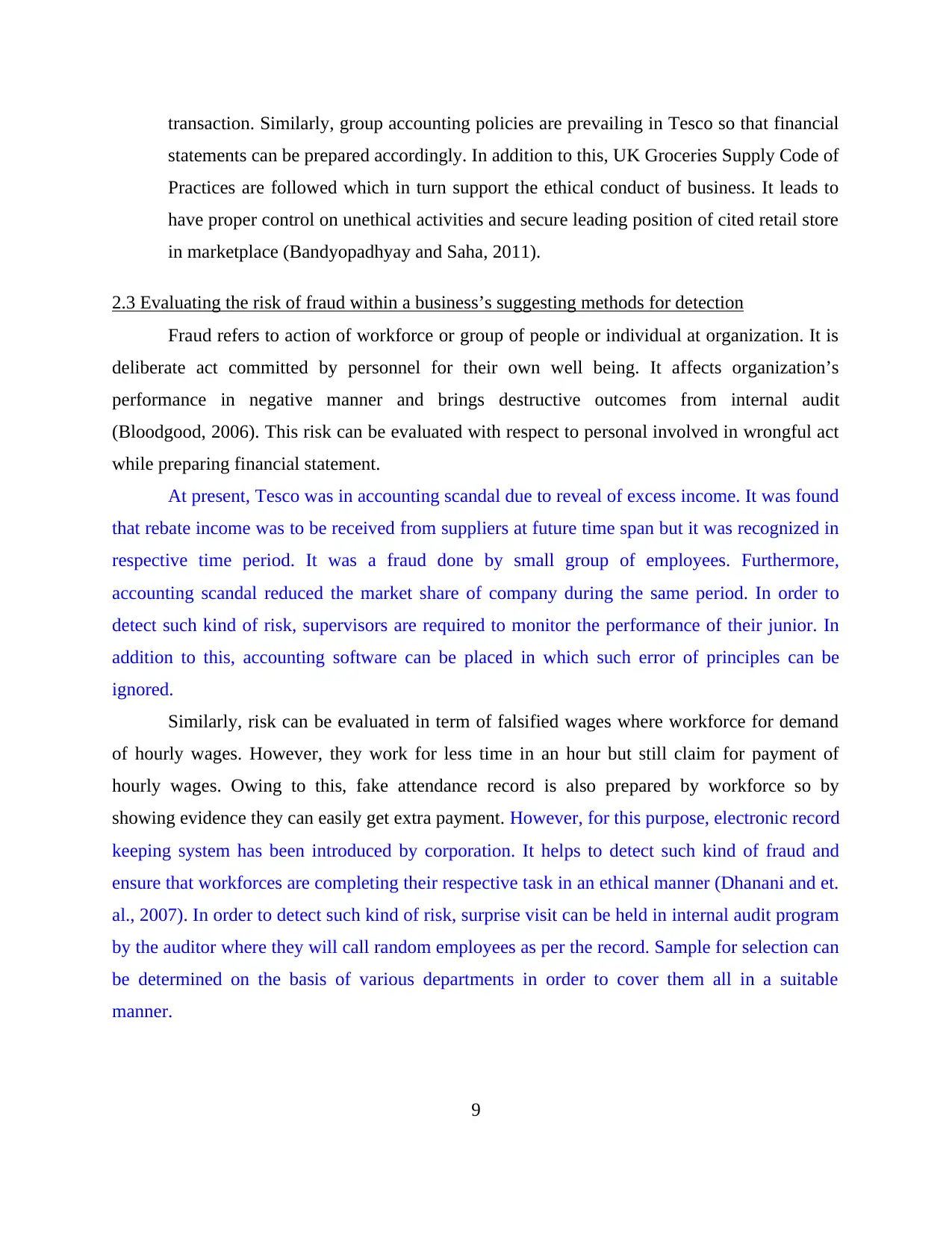
transaction. Similarly, group accounting policies are prevailing in Tesco so that financial
statements can be prepared accordingly. In addition to this, UK Groceries Supply Code of
Practices are followed which in turn support the ethical conduct of business. It leads to
have proper control on unethical activities and secure leading position of cited retail store
in marketplace (Bandyopadhyay and Saha, 2011).
2.3 Evaluating the risk of fraud within a business’s suggesting methods for detection
Fraud refers to action of workforce or group of people or individual at organization. It is
deliberate act committed by personnel for their own well being. It affects organization’s
performance in negative manner and brings destructive outcomes from internal audit
(Bloodgood, 2006). This risk can be evaluated with respect to personal involved in wrongful act
while preparing financial statement.
At present, Tesco was in accounting scandal due to reveal of excess income. It was found
that rebate income was to be received from suppliers at future time span but it was recognized in
respective time period. It was a fraud done by small group of employees. Furthermore,
accounting scandal reduced the market share of company during the same period. In order to
detect such kind of risk, supervisors are required to monitor the performance of their junior. In
addition to this, accounting software can be placed in which such error of principles can be
ignored.
Similarly, risk can be evaluated in term of falsified wages where workforce for demand
of hourly wages. However, they work for less time in an hour but still claim for payment of
hourly wages. Owing to this, fake attendance record is also prepared by workforce so by
showing evidence they can easily get extra payment. However, for this purpose, electronic record
keeping system has been introduced by corporation. It helps to detect such kind of fraud and
ensure that workforces are completing their respective task in an ethical manner (Dhanani and et.
al., 2007). In order to detect such kind of risk, surprise visit can be held in internal audit program
by the auditor where they will call random employees as per the record. Sample for selection can
be determined on the basis of various departments in order to cover them all in a suitable
manner.
9
statements can be prepared accordingly. In addition to this, UK Groceries Supply Code of
Practices are followed which in turn support the ethical conduct of business. It leads to
have proper control on unethical activities and secure leading position of cited retail store
in marketplace (Bandyopadhyay and Saha, 2011).
2.3 Evaluating the risk of fraud within a business’s suggesting methods for detection
Fraud refers to action of workforce or group of people or individual at organization. It is
deliberate act committed by personnel for their own well being. It affects organization’s
performance in negative manner and brings destructive outcomes from internal audit
(Bloodgood, 2006). This risk can be evaluated with respect to personal involved in wrongful act
while preparing financial statement.
At present, Tesco was in accounting scandal due to reveal of excess income. It was found
that rebate income was to be received from suppliers at future time span but it was recognized in
respective time period. It was a fraud done by small group of employees. Furthermore,
accounting scandal reduced the market share of company during the same period. In order to
detect such kind of risk, supervisors are required to monitor the performance of their junior. In
addition to this, accounting software can be placed in which such error of principles can be
ignored.
Similarly, risk can be evaluated in term of falsified wages where workforce for demand
of hourly wages. However, they work for less time in an hour but still claim for payment of
hourly wages. Owing to this, fake attendance record is also prepared by workforce so by
showing evidence they can easily get extra payment. However, for this purpose, electronic record
keeping system has been introduced by corporation. It helps to detect such kind of fraud and
ensure that workforces are completing their respective task in an ethical manner (Dhanani and et.
al., 2007). In order to detect such kind of risk, surprise visit can be held in internal audit program
by the auditor where they will call random employees as per the record. Sample for selection can
be determined on the basis of various departments in order to cover them all in a suitable
manner.
9
⊘ This is a preview!⊘
Do you want full access?
Subscribe today to unlock all pages.

Trusted by 1+ million students worldwide
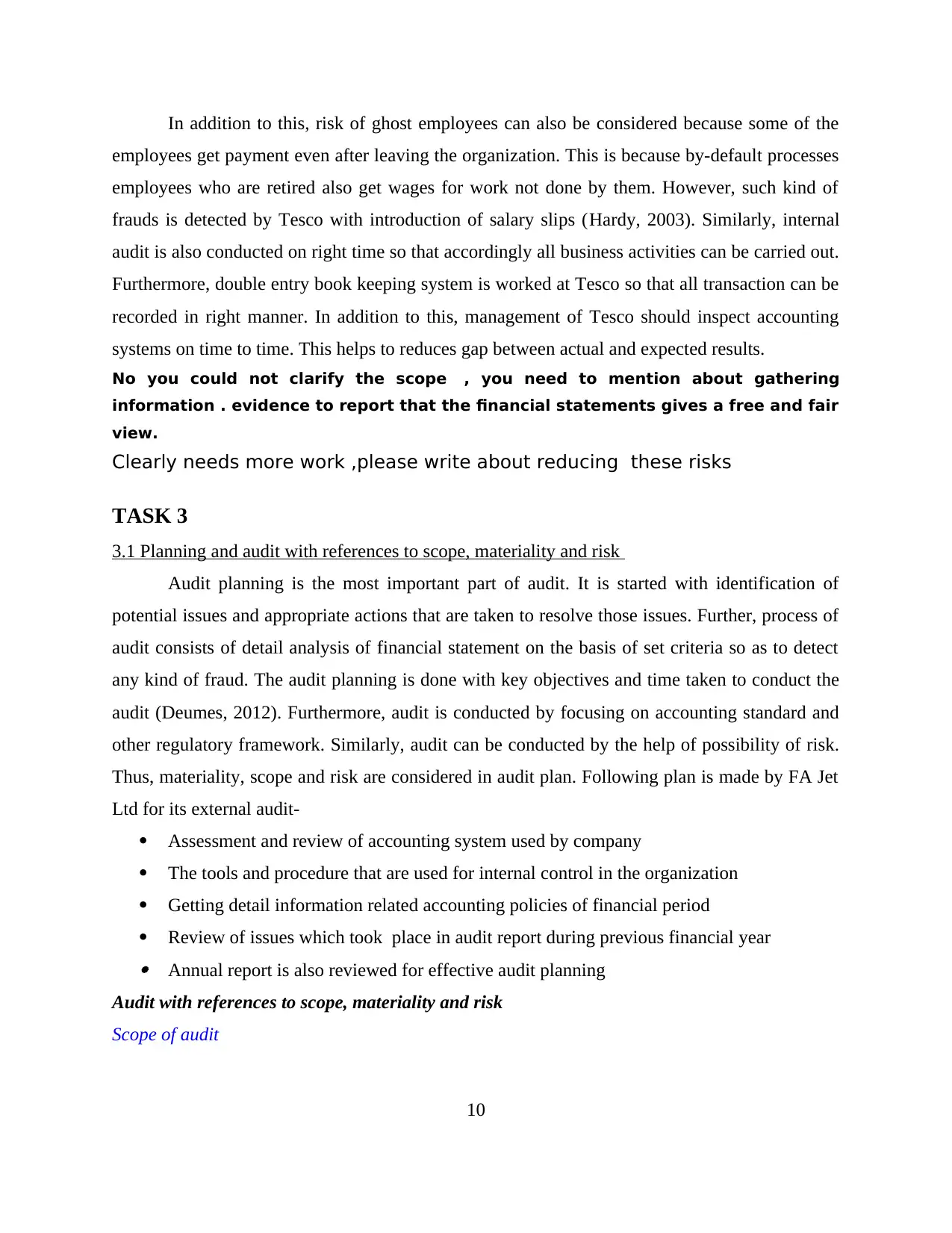
In addition to this, risk of ghost employees can also be considered because some of the
employees get payment even after leaving the organization. This is because by-default processes
employees who are retired also get wages for work not done by them. However, such kind of
frauds is detected by Tesco with introduction of salary slips (Hardy, 2003). Similarly, internal
audit is also conducted on right time so that accordingly all business activities can be carried out.
Furthermore, double entry book keeping system is worked at Tesco so that all transaction can be
recorded in right manner. In addition to this, management of Tesco should inspect accounting
systems on time to time. This helps to reduces gap between actual and expected results.
No you could not clarify the scope , you need to mention about gathering
information . evidence to report that the financial statements gives a free and fair
view.
Clearly needs more work ,please write about reducing these risks
TASK 3
3.1 Planning and audit with references to scope, materiality and risk
Audit planning is the most important part of audit. It is started with identification of
potential issues and appropriate actions that are taken to resolve those issues. Further, process of
audit consists of detail analysis of financial statement on the basis of set criteria so as to detect
any kind of fraud. The audit planning is done with key objectives and time taken to conduct the
audit (Deumes, 2012). Furthermore, audit is conducted by focusing on accounting standard and
other regulatory framework. Similarly, audit can be conducted by the help of possibility of risk.
Thus, materiality, scope and risk are considered in audit plan. Following plan is made by FA Jet
Ltd for its external audit-
Assessment and review of accounting system used by company
The tools and procedure that are used for internal control in the organization
Getting detail information related accounting policies of financial period
Review of issues which took place in audit report during previous financial year Annual report is also reviewed for effective audit planning
Audit with references to scope, materiality and risk
Scope of audit
10
employees get payment even after leaving the organization. This is because by-default processes
employees who are retired also get wages for work not done by them. However, such kind of
frauds is detected by Tesco with introduction of salary slips (Hardy, 2003). Similarly, internal
audit is also conducted on right time so that accordingly all business activities can be carried out.
Furthermore, double entry book keeping system is worked at Tesco so that all transaction can be
recorded in right manner. In addition to this, management of Tesco should inspect accounting
systems on time to time. This helps to reduces gap between actual and expected results.
No you could not clarify the scope , you need to mention about gathering
information . evidence to report that the financial statements gives a free and fair
view.
Clearly needs more work ,please write about reducing these risks
TASK 3
3.1 Planning and audit with references to scope, materiality and risk
Audit planning is the most important part of audit. It is started with identification of
potential issues and appropriate actions that are taken to resolve those issues. Further, process of
audit consists of detail analysis of financial statement on the basis of set criteria so as to detect
any kind of fraud. The audit planning is done with key objectives and time taken to conduct the
audit (Deumes, 2012). Furthermore, audit is conducted by focusing on accounting standard and
other regulatory framework. Similarly, audit can be conducted by the help of possibility of risk.
Thus, materiality, scope and risk are considered in audit plan. Following plan is made by FA Jet
Ltd for its external audit-
Assessment and review of accounting system used by company
The tools and procedure that are used for internal control in the organization
Getting detail information related accounting policies of financial period
Review of issues which took place in audit report during previous financial year Annual report is also reviewed for effective audit planning
Audit with references to scope, materiality and risk
Scope of audit
10
Paraphrase This Document
Need a fresh take? Get an instant paraphrase of this document with our AI Paraphraser
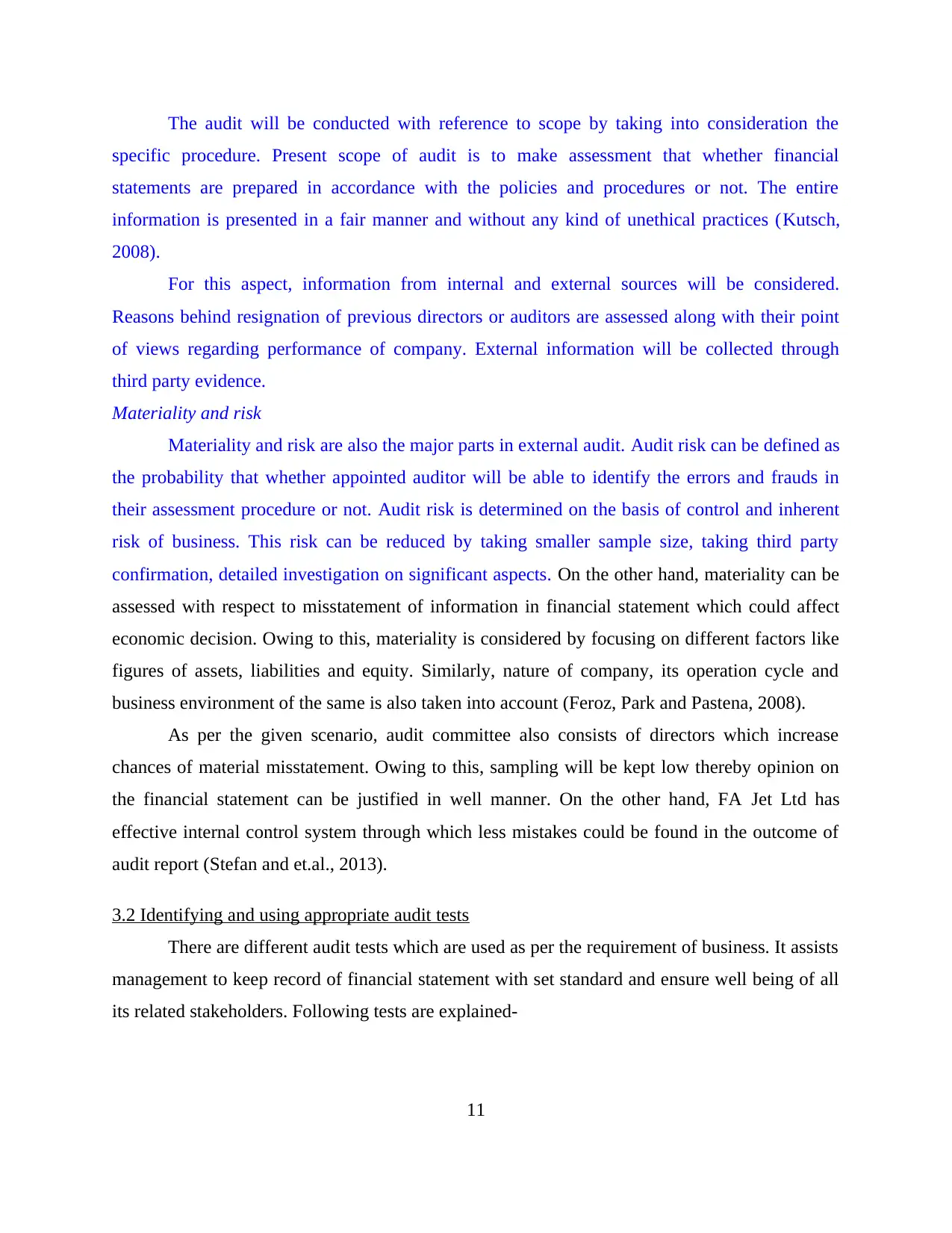
The audit will be conducted with reference to scope by taking into consideration the
specific procedure. Present scope of audit is to make assessment that whether financial
statements are prepared in accordance with the policies and procedures or not. The entire
information is presented in a fair manner and without any kind of unethical practices (Kutsch,
2008).
For this aspect, information from internal and external sources will be considered.
Reasons behind resignation of previous directors or auditors are assessed along with their point
of views regarding performance of company. External information will be collected through
third party evidence.
Materiality and risk
Materiality and risk are also the major parts in external audit. Audit risk can be defined as
the probability that whether appointed auditor will be able to identify the errors and frauds in
their assessment procedure or not. Audit risk is determined on the basis of control and inherent
risk of business. This risk can be reduced by taking smaller sample size, taking third party
confirmation, detailed investigation on significant aspects. On the other hand, materiality can be
assessed with respect to misstatement of information in financial statement which could affect
economic decision. Owing to this, materiality is considered by focusing on different factors like
figures of assets, liabilities and equity. Similarly, nature of company, its operation cycle and
business environment of the same is also taken into account (Feroz, Park and Pastena, 2008).
As per the given scenario, audit committee also consists of directors which increase
chances of material misstatement. Owing to this, sampling will be kept low thereby opinion on
the financial statement can be justified in well manner. On the other hand, FA Jet Ltd has
effective internal control system through which less mistakes could be found in the outcome of
audit report (Stefan and et.al., 2013).
3.2 Identifying and using appropriate audit tests
There are different audit tests which are used as per the requirement of business. It assists
management to keep record of financial statement with set standard and ensure well being of all
its related stakeholders. Following tests are explained-
11
specific procedure. Present scope of audit is to make assessment that whether financial
statements are prepared in accordance with the policies and procedures or not. The entire
information is presented in a fair manner and without any kind of unethical practices (Kutsch,
2008).
For this aspect, information from internal and external sources will be considered.
Reasons behind resignation of previous directors or auditors are assessed along with their point
of views regarding performance of company. External information will be collected through
third party evidence.
Materiality and risk
Materiality and risk are also the major parts in external audit. Audit risk can be defined as
the probability that whether appointed auditor will be able to identify the errors and frauds in
their assessment procedure or not. Audit risk is determined on the basis of control and inherent
risk of business. This risk can be reduced by taking smaller sample size, taking third party
confirmation, detailed investigation on significant aspects. On the other hand, materiality can be
assessed with respect to misstatement of information in financial statement which could affect
economic decision. Owing to this, materiality is considered by focusing on different factors like
figures of assets, liabilities and equity. Similarly, nature of company, its operation cycle and
business environment of the same is also taken into account (Feroz, Park and Pastena, 2008).
As per the given scenario, audit committee also consists of directors which increase
chances of material misstatement. Owing to this, sampling will be kept low thereby opinion on
the financial statement can be justified in well manner. On the other hand, FA Jet Ltd has
effective internal control system through which less mistakes could be found in the outcome of
audit report (Stefan and et.al., 2013).
3.2 Identifying and using appropriate audit tests
There are different audit tests which are used as per the requirement of business. It assists
management to keep record of financial statement with set standard and ensure well being of all
its related stakeholders. Following tests are explained-
11
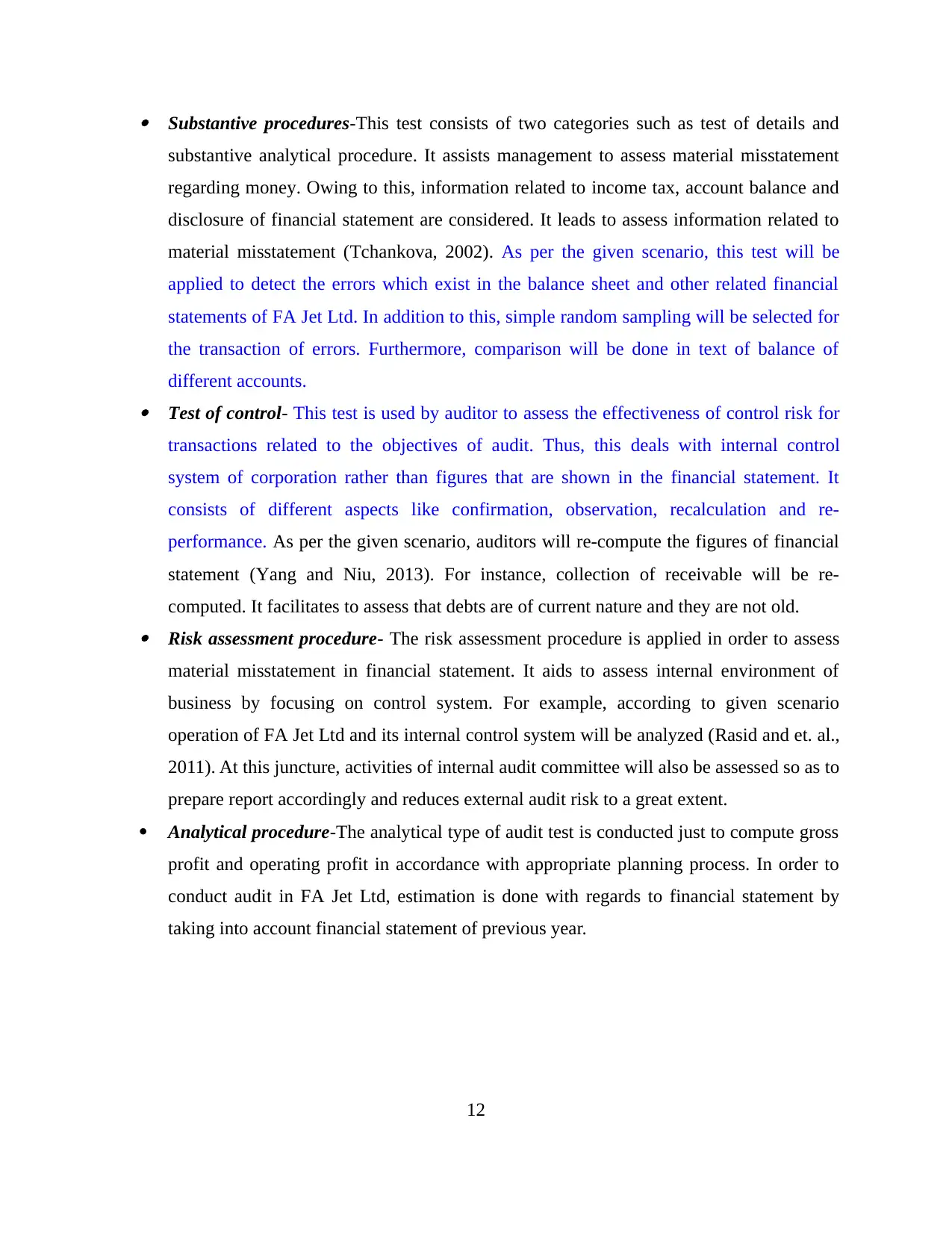
Substantive procedures-This test consists of two categories such as test of details and
substantive analytical procedure. It assists management to assess material misstatement
regarding money. Owing to this, information related to income tax, account balance and
disclosure of financial statement are considered. It leads to assess information related to
material misstatement (Tchankova, 2002). As per the given scenario, this test will be
applied to detect the errors which exist in the balance sheet and other related financial
statements of FA Jet Ltd. In addition to this, simple random sampling will be selected for
the transaction of errors. Furthermore, comparison will be done in text of balance of
different accounts. Test of control- This test is used by auditor to assess the effectiveness of control risk for
transactions related to the objectives of audit. Thus, this deals with internal control
system of corporation rather than figures that are shown in the financial statement. It
consists of different aspects like confirmation, observation, recalculation and re-
performance. As per the given scenario, auditors will re-compute the figures of financial
statement (Yang and Niu, 2013). For instance, collection of receivable will be re-
computed. It facilitates to assess that debts are of current nature and they are not old. Risk assessment procedure- The risk assessment procedure is applied in order to assess
material misstatement in financial statement. It aids to assess internal environment of
business by focusing on control system. For example, according to given scenario
operation of FA Jet Ltd and its internal control system will be analyzed (Rasid and et. al.,
2011). At this juncture, activities of internal audit committee will also be assessed so as to
prepare report accordingly and reduces external audit risk to a great extent.
Analytical procedure-The analytical type of audit test is conducted just to compute gross
profit and operating profit in accordance with appropriate planning process. In order to
conduct audit in FA Jet Ltd, estimation is done with regards to financial statement by
taking into account financial statement of previous year.
12
substantive analytical procedure. It assists management to assess material misstatement
regarding money. Owing to this, information related to income tax, account balance and
disclosure of financial statement are considered. It leads to assess information related to
material misstatement (Tchankova, 2002). As per the given scenario, this test will be
applied to detect the errors which exist in the balance sheet and other related financial
statements of FA Jet Ltd. In addition to this, simple random sampling will be selected for
the transaction of errors. Furthermore, comparison will be done in text of balance of
different accounts. Test of control- This test is used by auditor to assess the effectiveness of control risk for
transactions related to the objectives of audit. Thus, this deals with internal control
system of corporation rather than figures that are shown in the financial statement. It
consists of different aspects like confirmation, observation, recalculation and re-
performance. As per the given scenario, auditors will re-compute the figures of financial
statement (Yang and Niu, 2013). For instance, collection of receivable will be re-
computed. It facilitates to assess that debts are of current nature and they are not old. Risk assessment procedure- The risk assessment procedure is applied in order to assess
material misstatement in financial statement. It aids to assess internal environment of
business by focusing on control system. For example, according to given scenario
operation of FA Jet Ltd and its internal control system will be analyzed (Rasid and et. al.,
2011). At this juncture, activities of internal audit committee will also be assessed so as to
prepare report accordingly and reduces external audit risk to a great extent.
Analytical procedure-The analytical type of audit test is conducted just to compute gross
profit and operating profit in accordance with appropriate planning process. In order to
conduct audit in FA Jet Ltd, estimation is done with regards to financial statement by
taking into account financial statement of previous year.
12
⊘ This is a preview!⊘
Do you want full access?
Subscribe today to unlock all pages.

Trusted by 1+ million students worldwide
1 out of 18
Related Documents
Your All-in-One AI-Powered Toolkit for Academic Success.
+13062052269
info@desklib.com
Available 24*7 on WhatsApp / Email
![[object Object]](/_next/static/media/star-bottom.7253800d.svg)
Unlock your academic potential
Copyright © 2020–2025 A2Z Services. All Rights Reserved. Developed and managed by ZUCOL.





